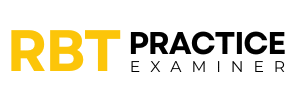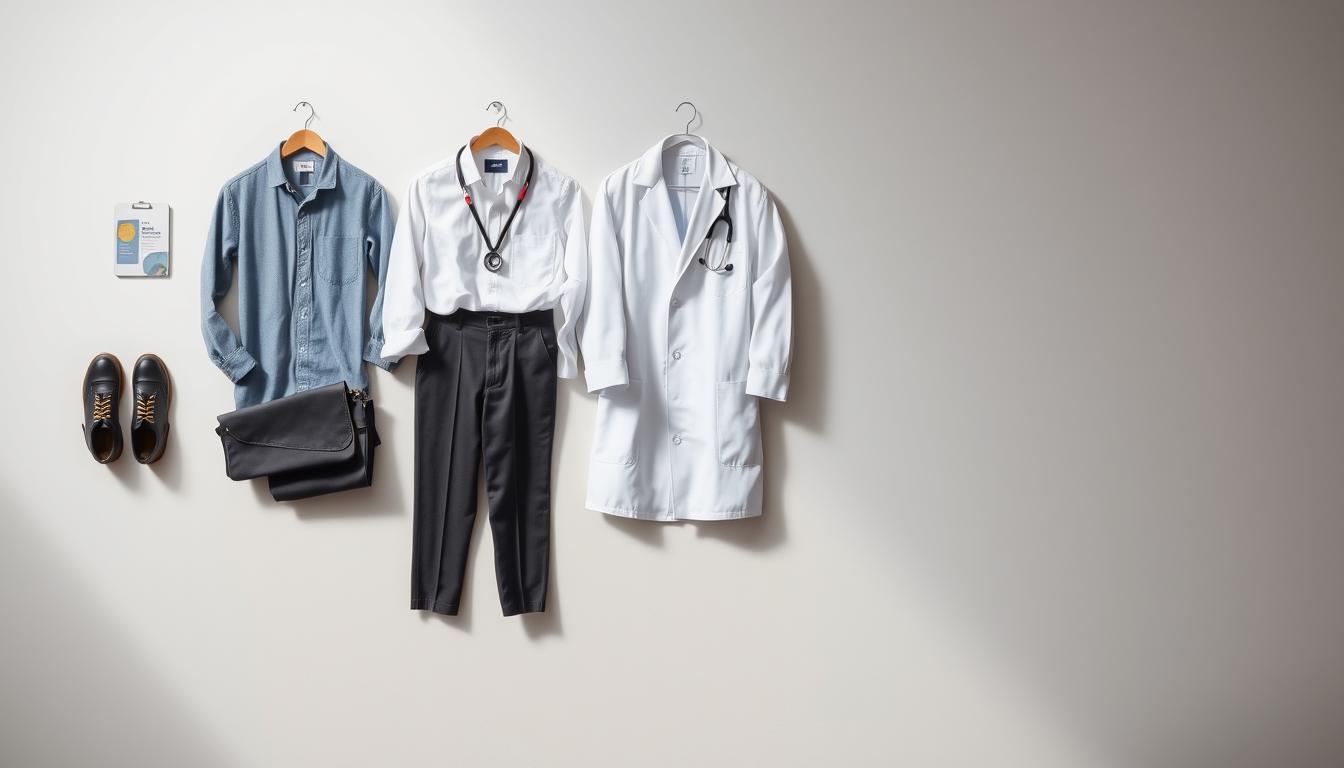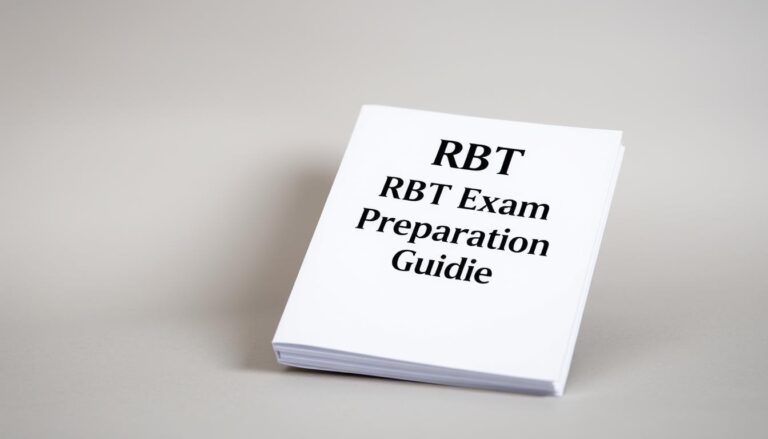The Smart Guide to RBT Attire: Dress Right, Work Bright”
Choosing what to wear as a behavior technician is key. It shows you’re ready to work well in Applied Behavior Analysis (ABA) therapy. Your clothes say a lot about your professionalism and respect for others.
Registered Behavior Technicians (RBTs) know their clothes matter a lot. It’s not just about looking good. It’s about being ready for work and making good connections with clients and colleagues.
ABA therapy experts know that what you wear matters a lot. It makes clients feel comfortable and helps build strong relationships. Whether you’re in a clinic or at home, your clothes show you care.
This guide will help you understand what to wear. We’ll talk about dress codes and how to pick clothes that are both professional and comfortable. Whether you’re new or looking to improve, these tips will help you dress with confidence.
Understanding RBT Professional Dress Code Essentials
Registered Behavior Technicians (RBTs) are key in therapy support. Their clothes show more than style. They show competence, build trust, and keep clients safe.
Knowing RBT dress code rules is important. It’s about being professional, comfortable, and practical. The right clothes help with client relationships and work success.
Workplace Policy Compliance
Every workplace has its own dress code for RBTs. These rules usually include:
- Solid, neutral-colored clothing
- Minimal accessories
- Clean, wrinkle-free garments
- Comfortable, professional fit
Client-Centered Appearance Standards
RBT clothes should be approachable and professional. How you look matters in building trust with clients.
| Clothing Aspect | Recommended Practice |
|---|---|
| Color Choices | Soft, calming colors that don’t overstimulate clients |
| Fit | Loose enough for movement, not baggy |
| Fabric | Breathable, durable materials |
Safety Considerations in Attire Selection
Choosing safe clothes is critical for RBTs. They need clothes that:
- Allow easy movement during interventions
- Don’t have dangling accessories
- Have closed-toe shoes
- Protect against physical interactions
Following these dress code rules shows RBTs are professional. It also keeps the focus on the client in therapy.
What Do RBT Wear: A Complete Guide
Registered Behavior Technicians (RBTs) need a wardrobe that’s both professional and comfortable. They focus on dressing in a way that helps them interact well with clients. This also keeps their professional image high.
There are a few main things to think about when it comes to RBTs’ clothes:
- Comfort for active movement
- Professional appearance
- Safety for both client and technician
- Adaptability to different work environments
RBTs usually wear:
- Comfortable, fitted clothing that lets them move easily
- Neutral-colored tops and bottoms
- Closed-toe shoes with good traction
- Minimal jewelry and accessories
Different places might need different clothes. Clinics might want more formal outfits. But home visits might be a bit more casual. Yet, RBTs always aim for a clean, neat look. This look helps build trust with clients and their families.
The main goal of RBTs’ dress code is to make a safe, welcoming space. This space supports their work in helping clients.
Professional Appearance Standards for Behavior Technicians
Appearance is key for behavior technicians. It’s not just about what you wear. It’s about making a good first impression and building trust with clients and their families.
Professional attire for behavior technicians is important. It shows you are competent, respectful, and committed to helping. When picking out your work clothes, keep these tips in mind:
- Choose clean, well-maintained clothing
- Select comfortable yet professional garments
- Prioritize client comfort and safety
- Reflect cultural sensitivity in your dress
Building Client Trust Through Appearance
Your look says a lot before you start working with a client. A neat, professional outfit shows you are reliable and skilled. Dress in a way that makes clients and their families feel safe and respected.
Cultural Sensitivity in Dress Choices
It’s important to understand different cultures when choosing your clothes. Different communities have their own ideas about what is professional. Always try to be respectful and considerate of these differences in your outfit.
Maintaining Professional Boundaries
Clothing is key in setting and keeping professional boundaries. Your outfit should be modest, practical, and suitable for working with people of all ages. Stay away from too casual or revealing clothes that could harm the therapeutic relationship.
Selecting Appropriate Tops and Shirts for RBT Work
Choosing the right tops for RBT work is important. The clothes a Registered Behavior Technician (RBT) wears help build trust and show professionalism. This is key when working with clients.
When picking shirts for RBT work, think about a few things:
- Comfort during active therapy sessions
- Professional appearance
- Durability of fabric
- Ease of movement
So, what should RBTs wear on their tops? The best shirt is one that looks good and is practical. Solid colors and neutral tones are best. Avoid patterns or designs that might distract clients.
| Shirt Type | Recommended | Avoid |
|---|---|---|
| Neckline | Crew neck, V-neck | Low-cut or revealing styles |
| Sleeve Length | Short to mid-length sleeves | Extremely loose or tight sleeves |
| Fabric | Breathable cotton blends | Transparent or overly delicate materials |
RBTs need shirts that let them move freely during therapy. Look for stretchy, comfy fabrics that also look professional. Polo shirts and button-up shirts in the right colors are great for both clinic and home settings.
Remember, your clothes show your professionalism and help build trust. Choose tops that are clean, well-kept, and right for your work place.
Comfortable yet Professional Bottom Wear Options
Choosing the right bottom wear is key for Registered Behavior Technicians (RBTs). They need to look professional but also be comfortable with clients. Pants, slacks, and skirts should meet both practical and professional standards.
The dress code for RBTs stresses the need for clothes that are both mobile and polished. The right clothes can greatly affect your work and how clients feel.
Pants and Slacks Guidelines
- Choose wrinkle-resistant fabrics that stay crisp
- Opt for neutral colors like navy, black, or khaki
- Select comfortable fits that allow easy movement
- Avoid tight or restrictive clothing
Professional pants should fit well but not be too tight. Straight-leg or slightly tapered styles are best for RBTs who need to move quickly and comfortably.
Appropriate Skirt Lengths and Styles
For those who prefer skirts, RBT dress code requirements suggest modest lengths. These lengths ensure a professional look and are practical.
| Skirt Type | Recommended Length | Professional Suitability |
|---|---|---|
| A-line Skirt | Knee-length | Excellent mobility, professional look |
| Pencil Skirt | Just above knee | Professional, slightly structured |
| Wrap Skirt | Midi length | Comfortable, versatile |
Always choose comfort and professional appearance when picking bottom wear for RBT work. The right clothes show respect for clients and keep a professional image.
Footwear Requirements for RBT Professionals
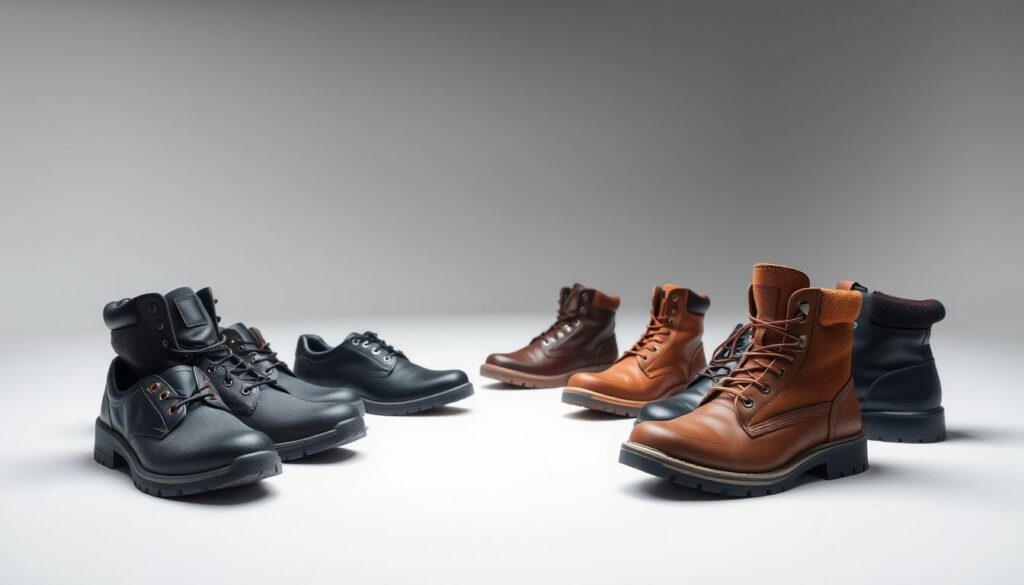
Choosing the right shoes is key for behavior technician attire. The best shoes for RBTs offer comfort, safety, and a professional look. They spend a lot of time on their feet, so good shoes are vital.
When picking out shoes for RBT work, consider a few important things:
- Comfort for long hours of standing and walking
- Closed-toe design for safety
- Supportive arch and heel cushioning
- Non-slip soles for different places
The best shoes for RBTs should be comfy and look professional. Practical yet polished shoes can really help your work and how you interact with clients.
| Shoe Type | Recommended Features | Professional Rating |
|---|---|---|
| Athletic Sneakers | Supportive, comfortable, quiet soles | High |
| Leather Walking Shoes | Professional look, good support | Very High |
| Comfortable Loafers | Slip-on style, professional appearance | Moderate |
Stay away from shoes with loud colors or designs. Stick to neutral colors like black, navy, or dark gray. Choose shoes that let you move easily and quietly, while looking professional.
Remember, your shoes are a big part of how you look as a professional. Good, comfy shoes will help you both physically and in your job as an RBT.
Seasonal Dress Adaptations for RBT Work
Registered behavior technicians (RBTs) have to pick their clothes wisely with the seasons. They need clothes that are both professional and comfortable all year round.
Choosing what to wear as an RBT requires careful planning. It’s about looking professional while dealing with changing temperatures and client needs.
Summer Clothing Solutions
In the summer, RBTs should wear light, breathable clothes. This keeps them cool and comfy. Here are some tips for summer:
- Lightweight cotton shirts in neutral colors
- Breathable, loose-fitting slacks
- Short-sleeve polo shirts with professional collars
- Moisture-wicking undergarments
Pro tip: Light-colored clothes reflect heat and look crisp and professional.
Winter Layering Strategies
In the cold, RBTs need to dress smartly. Layering is key for staying warm and flexible with clients.
- Start with a thin, moisture-wicking base layer
- Add a professional sweater or cardigan
- Select a lightweight, neutral-colored jacket
- Opt for closed-toe shoes with good traction
The goal is to have a wardrobe that’s easy to adjust. This way, you can look professional whether you’re indoors or outdoors.
Personal Grooming and Hygiene Standards
Being well-dressed is just the start for RBTs. How you look personally is key to building trust with clients. It’s not just about what you wear.
Keeping yourself clean is vital for RBTs. Looking neat shows respect for your clients and the job. Here are some grooming tips:
- Regular hair maintenance with neat, clean hairstyles
- Trimmed and clean nails
- Fresh breath and minimal use of strong fragrances
- Clean, pressed clothing
Good personal hygiene shows you’re serious about your work and care for your clients. It helps make a space where clients feel at ease.
Here are some extra tips for RBTs:
- Wear minimal jewelry to avoid distractions
- Keep your fingernails short and clean for safety
- Use subtle, natural makeup if you choose to
- Stick to neutral, professional scents
Good grooming is more than just looking good. It makes a safe, welcoming place for clients to learn. RBTs who take grooming seriously show they respect their work.
Accessories and Jewelry Guidelines for RBTs
Choosing the right accessories is key for RBTs. They must pick items that are both professional and safe. This ensures clients feel comfortable and work is done well.
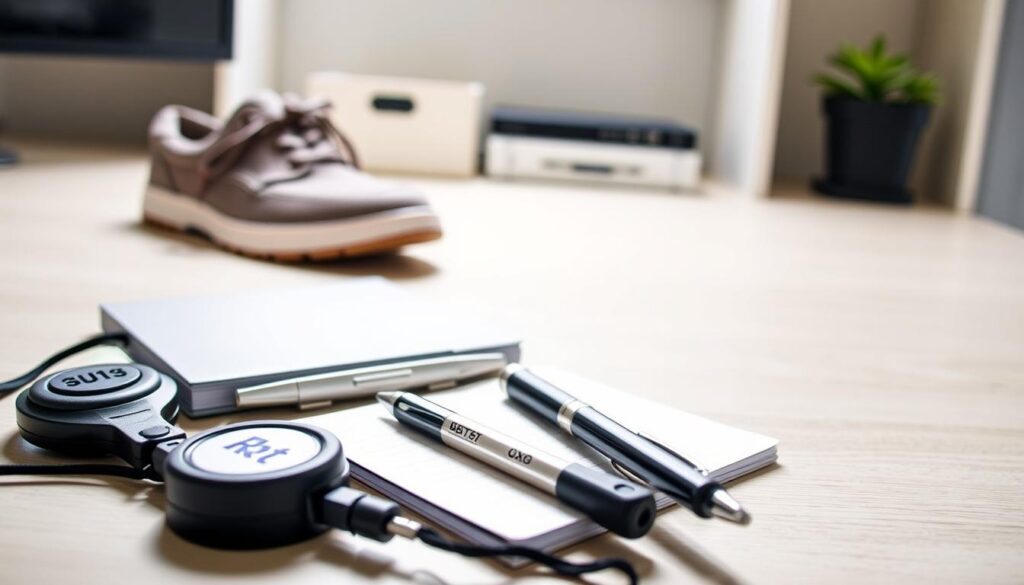
Accessories are important in RBT work. They help create a safe and welcoming space. The right ones can also boost your professional look.
Safety-Conscious Accessory Choices
Safety is the top priority for RBT accessories. Here are some important tips:
- Avoid dangling earrings that could be grabbed by clients
- Choose watches with smooth, flat surfaces
- Minimize jewelry to prevent distractions or safety risks
- Select sturdy, simple wedding bands if wearing rings
Professional Image Enhancement
Your accessories should match your professional clothes. But they shouldn’t get too much attention. In behavioral therapy, simple is best.
- Opt for small stud earrings
- Wear minimal, neutral-colored accessories
- Choose practical items that support your professional role
For RBTs, dress code rules focus on being both functional and professional. Your accessories should never get in the way of your work.
Color Choices and Their Impact on Client Interaction
Choosing the right colors for behavior technician clothes is key to a positive therapy setting. It’s not just about looking good—it’s about how color affects clients. The right outfit can make a big difference.
Colors send messages without words. When picking clothes, think about how colors affect feelings and engagement. Soft, neutral colors bring calm and reliability, which is vital in therapy.
- Blue: Represents trust and stability
- Green: Promotes feelings of relaxation
- Neutral tones: Provide a professional, non-threatening appearance
Stay away from bright or intense colors that might overwhelm clients, like those with sensory issues. Muted, professional color palettes are better. They keep things welcoming and professional.
When picking your outfit, remember these color tips:
- Match colors with your work environment
- Go for solid, predictable colors
- Steer clear of patterns that might distract
Knowing how color communicates can change how clients feel. It makes your clothes a powerful tool for building trust and comfort.
Dress Code Differences: Clinical vs. Home-Based Settings
Registered behavior technicians face different clothing challenges in various work settings. They need to dress professionally in both clinical and home-based environments. This ensures they look good and act professionally.
Knowing the dress code rules helps RBTs make a good first impression. They build trust with clients and their families.
Facility-Specific Requirements
Clinical settings have strict dress codes for safety and professionalism. RBTs should wear:
- Solid-colored, neutral scrubs or business casual attire
- Closed-toe shoes with non-slip soles
- Minimal, secure jewelry
- Neat, professional hairstyles
Home Visit Attire Considerations
Home-based therapy needs a more relaxed approach to clothes. RBTs should pick outfits that are:
- Comfortable for physical interaction
- Respectful of the family’s home environment
- Easy to move in during therapy sessions
- Modest and culturally sensitive
Pro tip: Always carry a professional jacket or layer that can be added or removed to match the home’s comfort level and maintain a polished appearance.
Budget-Friendly Professional Wardrobe Building
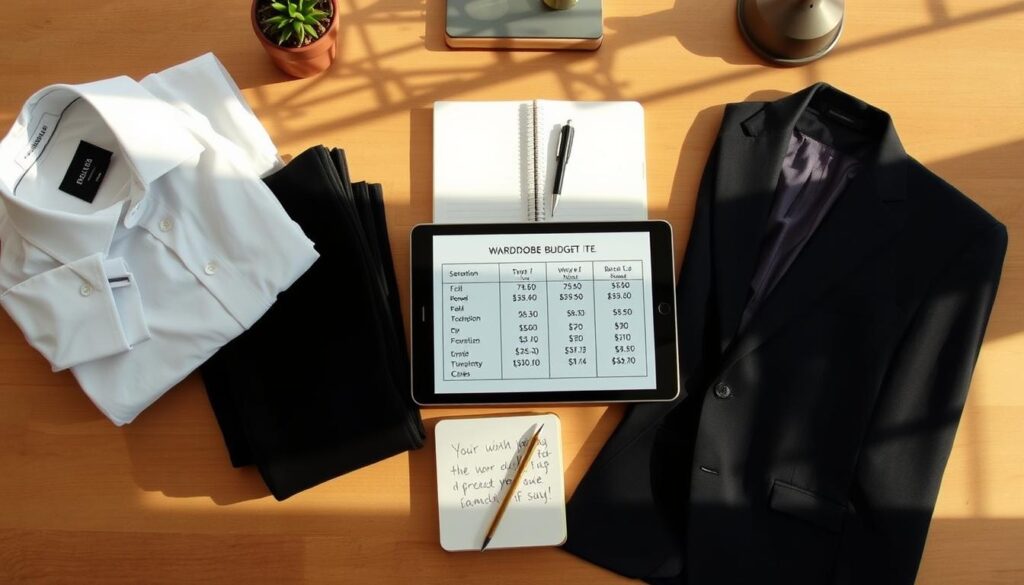
Building a professional wardrobe as a Registered Behavior Technician (RBT) doesn’t have to be expensive. Knowing what to wear is key to a stylish yet affordable wardrobe. This wardrobe should meet all professional standards.
Smart shopping can help you build a wardrobe that’s both practical and affordable. What should RBT wear that’s budget-friendly? Focus on neutral, mix-and-match pieces. These can be worn in many different ways.
- Invest in quality basic pieces like solid-colored shirts and neutral pants
- Choose wrinkle-resistant fabrics for easy maintenance
- Select versatile colors that coordinate easily
- Look for sales and discounts at professional clothing stores
Here are some budget-friendly places to find RBT professional attire:
| Store Type | Price Range | Pros |
|---|---|---|
| Consignment Shops | $-$$ | Gently used professional clothing at reduced prices |
| Outlet Stores | $$ | Brand-name clothing at discounted rates |
| Online Discount Retailers | $-$$ | Wide selection and competitive pricing |
When building your RBT wardrobe, focus on comfort, professionalism, and versatility. A few smart buys can help you create a professional wardrobe. This wardrobe will meet dress code requirements without emptying your wallet.
Maintaining Your Professional Wardrobe
Keeping your behavior technician attire in top shape is key for a professional look. It’s not just about washing clothes. It’s about keeping your clothes looking great for a long time.
Effective care for RBTs’ clothes involves a few important steps:
- Choose durable, high-quality clothes that can handle lots of washing
- Follow the care instructions for each fabric type
- Regularly check your clothes for any damage
- Use the right methods to remove stains
Managing stains is very important in behavior technician clothes. Act fast when you see a stain from a client. Keep a small stain removal kit at work. It should have:
- Stain removal pens
- Gentle fabric wipes
- Extra clothes for when you need them
Checking your wardrobe often keeps you looking sharp. Here are some tips:
- Switch up your clothes to avoid overuse
- Get new clothes when the old ones are too worn
- Choose clothes that can be mixed and matched
Even on a budget, RBTs can look professional. Pick clothes that are versatile, easy to clean, and comfortable. Focus on clothes that look good and last long.
Common Dress Code Mistakes to Avoid
Finding the right dress code for Registered Behavior Technicians (RBTs) can be tough. It’s not just about looking neat. It’s about showing a professional image that builds trust and safety with clients.
- Overly casual clothing that looks unprepared or disrespectful
- Revealing or tight-fitting clothes that cross professional boundaries
- Clothing with distracting graphics or messages that are not suitable
- Accessories that could be a safety risk during therapy
Inappropriate Clothing Choices
RBTs need to pick clothes that are both professional and practical. Clothes that limit movement or cause sensory issues should be avoided. Choose:
- Comfortable, well-fitting professional clothes
- Neutral colors that don’t overwhelm clients
- Sturdy, closed-toe shoes for safety
Professional Image Pitfalls
Your look says a lot before you even speak. Bad grooming, wrinkled clothes, or wrong accessories can hurt how clients see you. RBTs should aim for a clean, professional look that shows respect for clients and the therapy setting.
Remember, the right dress for RBTs is about building trust, safety, and professionalism. This supports effective behavioral intervention.
Conclusion
Mastering RBT dress code requirements is more than just picking the right clothes. It’s about showing a professional image. This image builds trust, ensures safety, and helps in delivering effective therapy.
Your outfit for RBTs is key in showing credibility and connecting with clients. The guidelines we’ve looked at show that professional clothes are a strong way to communicate. Each choice you make shows your commitment, respect for clients, and understanding of work expectations.
Every detail, from colors to shoes, adds to your professional look. Spending time on a good wardrobe strategy will help your RBT career. Your look shows you’re competent, reliable, and sensitive to the therapy settings.
By following these dress code tips, you’ll make a good first impression. This supports your clinical goals. Remember, your clothes show your skills and dedication. Choose them with care, just like you do with therapy, and you’ll succeed in this field.
